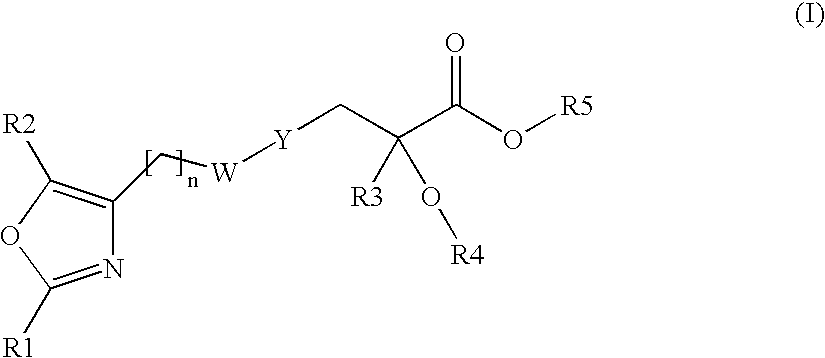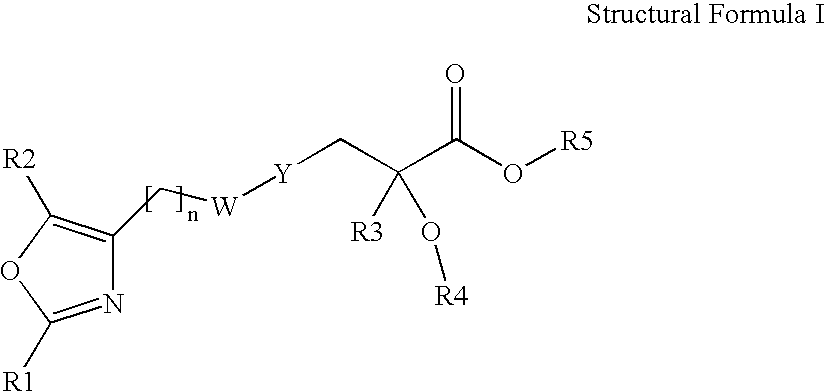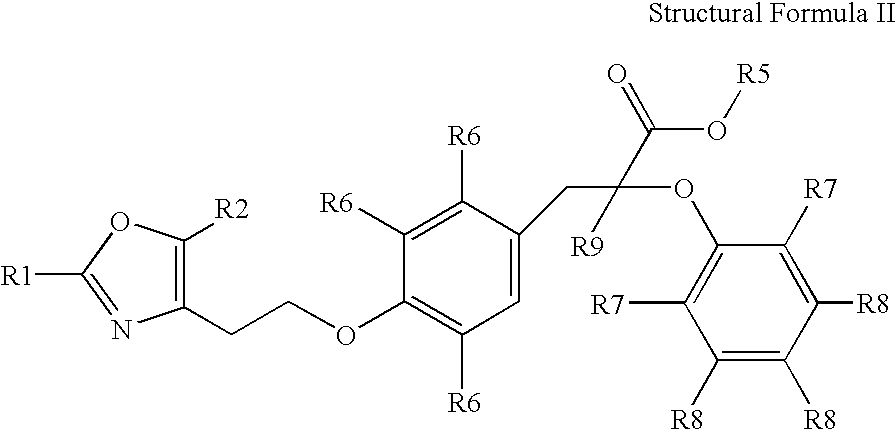Oxazolyl-arylproplonic acid derivatives and their use as ppar agonists
a technology of oxazolyl-arylproplonic acid and derivatives, which is applied in the direction of drug compositions, extracellular fluid disorders, metabolic disorders, etc., can solve the problems of poor compliance, inadequate insulin repression of lipolysis in adipose tissue, and insufficient insulin activation of glucose uptake, etc., to achieve fewer side effects
- Summary
- Abstract
- Description
- Claims
- Application Information
AI Technical Summary
Benefits of technology
Problems solved by technology
Method used
Image
Examples
example 1
rac-3-{4-[2-(2-Phenyl-5-methyl-oxazol-4-yl)-ethoxy]-phenyl}-2-methyl-2-phenoxy-propionic acid
[0119]
[0120]The title compound, shown above, was made as described below.
Step A
2-Phenoxypropionic acid ethyl ester
[0121]
[0122]Phenol (28.5 g, 0.30 mol), Cs2CO3 (197.0 g, 0.61 mol), and ethyl 2-bromopropionate (54.3 g, 0.30 mol) were combined in anhydrous N,N-dimethylformamide (DMF) (1000 mL) and stirred at 90° C. under an atmosphere of nitrogen. After 16 h, the DMF was removed in vacuo. The residue was dissolved in ethyl acetate (300 mL) and washed twice with water and once with brine. The organic layer was dried over Na2SO4 and concentrated in vacuo to produce 2-phenoxypropionic acid ethyl ester, shown above, as a golden oil (48.5 g, 83%) 1H NMR (250 MHz, CDCl3): δ 7.31 (d, 2H, J=7.8), 7.02 (t, 1H, J=7.9), 6.93 (d, 2H, J=7.8), 4.79 (q, 1H, J=6.1), 4.26 (q, 2H, J=7.2), 1.66 (d, 3H, J=6.1), 1.24 (t, 3H, J=7.2). MS [EI+] 195 (M+H)+.
Step B
2-Phenoxy-3-(4-benzyloxyphenyl)-2-methyl-propionic acid ...
example 2
(R)-3-{4-[2-(2-Phenyl-5-methyl-oxazol-4-yl)-ethoxy]-phenyl}-2-methyl-2-phenoxy-propionic acid
[0133]
[0134](R)-3-(4-hydroxyphenyl)-2-methyl-2-phenoxypropionic acid ethyl ester, shown below,
from Example 1, Step C, and toluene-4-sulfonic acid 2-(2-phenyl-5-methyloxazol-4-yl)-ethyl ester were reacted, as described in Example 1, Step D, to provide (R)-3-{4-[2-(2-phenyl-5-methyl-oxazol-4-yl)-ethoxy]-phenyl}-2-methyl-2-phenoxypropionic acid ethyl ester, shown below, as a colorless oil (61%). 1H NMR (300 MHz, CDCl3): δ 7.96 (m, 2H), 7.41 (m, 3H), 7.19 (t, 2H), 7.12 (d, 2H), 6.93 (t, 1H), 6.82 (m, 4H), 4.20 (q, 2H), 4.18 (t, 2H), 3.23 (d, 1H), 3.06 (d, 1H), 2.95 (t, 2H), 2.37 (s, 3H), 1.33 (s, 3H). MS [EI+] 486 (M+H)+, [EI−] 484 (M−H)+.
[0135]The title compound was then prepared from this phenoxy propionic acid ethyl ester, via the hydrolysis procedure of Example 1, Step E, to produce a white solid (99%). 1H NMR (300 MHz, d6-DMSO): δ 7.87 (m, 2H), 7.44 (m, 3H), 7.21 (dd, 2H, J=7.8, 8.8), 7.1...
example 3
(S)-3-{4-[2-(2-Phenyl-5-methyl-oxazol-4-yl)-ethoxy]-phenyl}-2-methyl-2-phenoxy-propionic acid
[0136]
[0137](S)-3-(4-hydroxyphenyl)-2-methyl-2-phenoxy-propionic acid ethyl ester, shown below,
from Example 1, Step C, and toluene-4-sulfonic acid 2-(2-phenyl-5-methyloxazol-4-yl)-ethyl ester were reacted, as described in Example 1, Step D, to provide (S)-3-{4-[2-(2-phenyl-5-methyl-oxazol-4-yl)-ethoxy]-phenyl}-2-methyl-2-phenoxypropionic acid ethyl ester, shown below, as a colorless oil (41%). 1H NMR (300 MHz, CDCl3): δ 7.96 (m, 2H), 7.41 (m, 3H), 7.19 (t, 2H), 7.12 (d, 2H), 6.93 (t, 1H), 6.82 (m, 4H), 4.20 (q, 2H), 4.18 (t, 2H), 3.23 (d, 1H), 3.06 (d, 1H), 2.95 (t, 2H), 2.37 (s, 3H), 1.33 (s, 3H). MS [EI+] 486 (M+H)+, [EI−] 484 (M−H)+.
[0138]The title compound was then prepared from this phenoxy propionic acid ethyl ester, via the hydrolysis procedure of Example 1, Step E, to produce a white solid (96%). 1H NMR (300 MHz, d6-DMSO): δ 7.87 (m, 2H), 7.44 (m, 3H), 7.21 (dd, 2H, J=7.8, 8.8), 7....
PUM
| Property | Measurement | Unit |
|---|---|---|
| Molar density | aaaaa | aaaaa |
| Molar density | aaaaa | aaaaa |
| Molar density | aaaaa | aaaaa |
Abstract
Description
Claims
Application Information
 Login to View More
Login to View More - R&D
- Intellectual Property
- Life Sciences
- Materials
- Tech Scout
- Unparalleled Data Quality
- Higher Quality Content
- 60% Fewer Hallucinations
Browse by: Latest US Patents, China's latest patents, Technical Efficacy Thesaurus, Application Domain, Technology Topic, Popular Technical Reports.
© 2025 PatSnap. All rights reserved.Legal|Privacy policy|Modern Slavery Act Transparency Statement|Sitemap|About US| Contact US: help@patsnap.com



